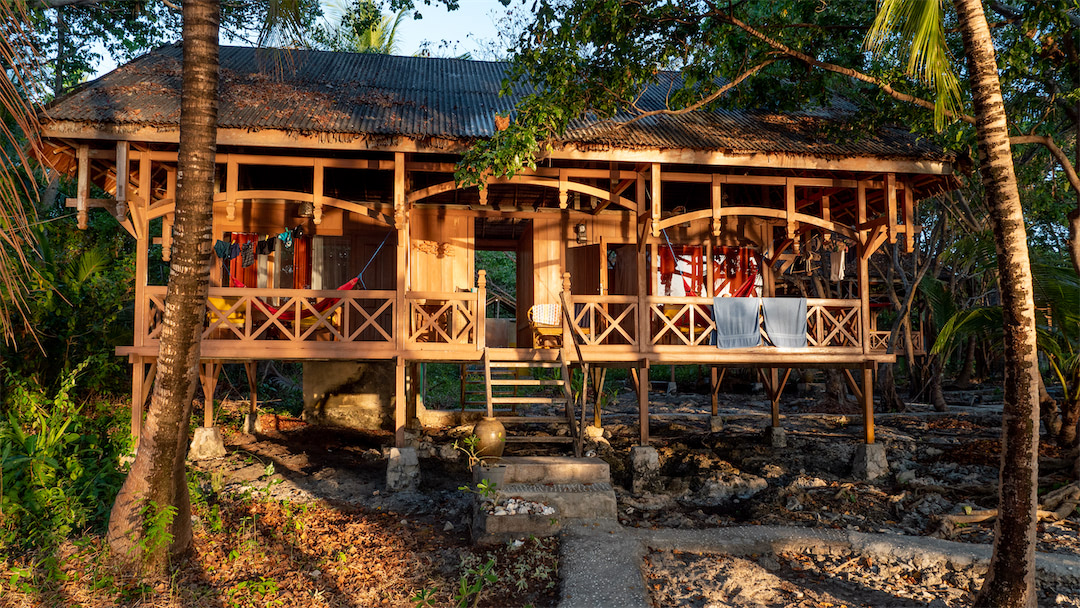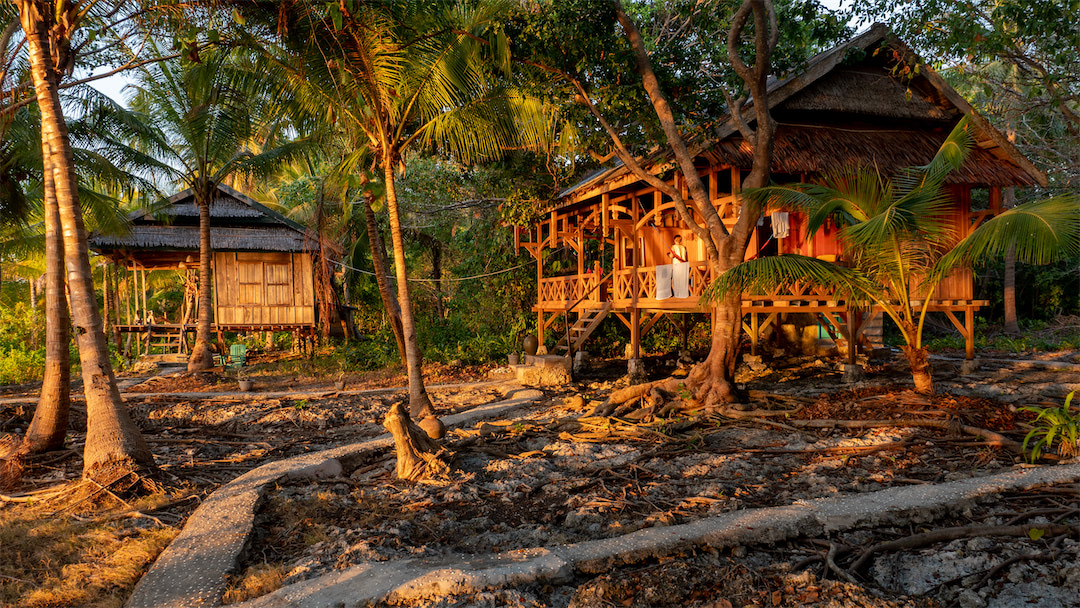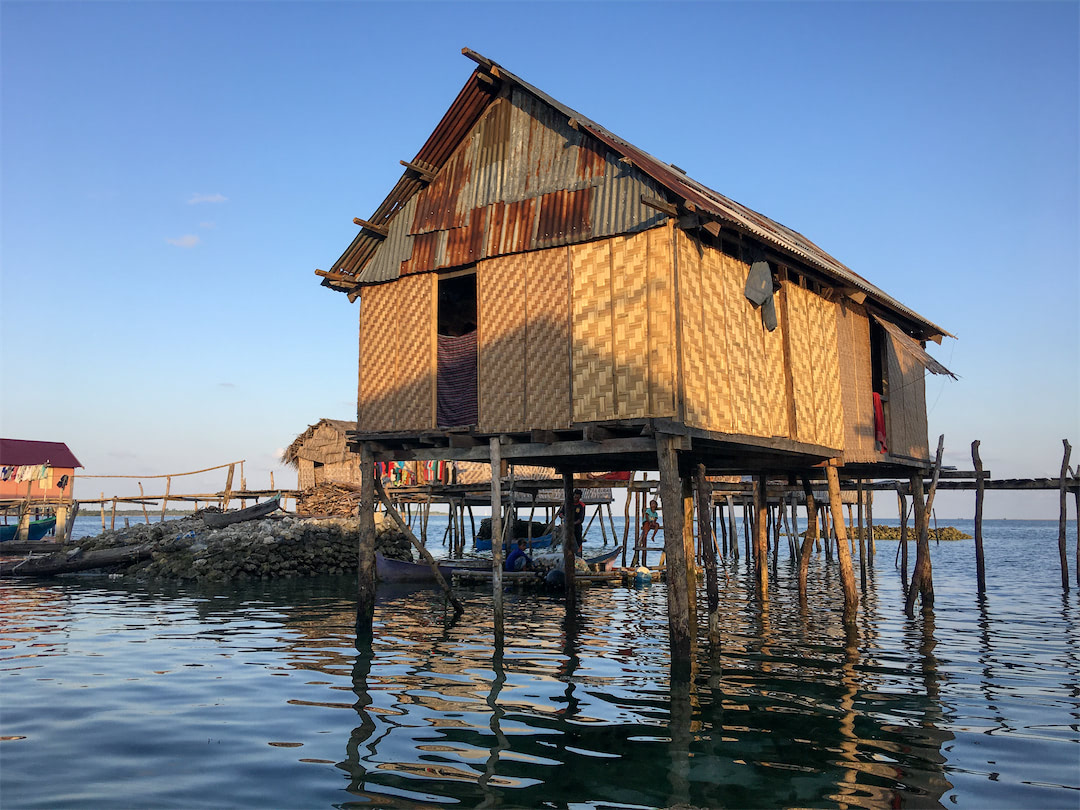Hoga is a small island northeast of Kaledupa. It is surrounded by an extensive coral reef. At low tide you can go around the entire island in just over an hour. However, this action should be postponed until the early hours of the morning. The tour turns out to be a sweaty affair.
Hoga gained some fame through Operation Wallacea. This non-profit nature conservation organization has been organizing summer camps on Hoga and other destinations in Indonesia for many years with students and other young people interested in nature conservation. During the July / August season, it is teeming with young people. Before and after it is calm on Hoga. In the off-season in October / November only a handful of travelers come by.
Hoga gained some fame through Operation Wallacea. This non-profit nature conservation organization has been organizing summer camps on Hoga and other destinations in Indonesia for many years with students and other young people interested in nature conservation. During the July / August season, it is teeming with young people. Before and after it is calm on Hoga. In the off-season in October / November only a handful of travelers come by.
Water scarcity
Unfortunately, Hoga has no fresh water source. Fresh water in sufficient quantities is not even available during the short rainy season. Drinking water must be transported by ship from Kaledupa to Hoga. Only brackish water from wells, the salt content of which has increased over the years, is available to guests for washing.
Operation Wallacea has therefore pulled the rip cord and accommodates the majority of their guests in the summer months on the neighboring island of Kaledupa in order not to burden the island's limited resources even further.
Individual travelers with the destination Hoga do not have a large selection when choosing their accommodation. Actually only the Hoga Island Dive Resort comes into question for them.
Although there are other accommodations and a rump crew from Operation Wallacea is also on site, I cannot recommend looking for a place to stay in this heavily mosquito-infested part of the island.
Operation Wallacea has therefore pulled the rip cord and accommodates the majority of their guests in the summer months on the neighboring island of Kaledupa in order not to burden the island's limited resources even further.
Individual travelers with the destination Hoga do not have a large selection when choosing their accommodation. Actually only the Hoga Island Dive Resort comes into question for them.
Although there are other accommodations and a rump crew from Operation Wallacea is also on site, I cannot recommend looking for a place to stay in this heavily mosquito-infested part of the island.
Hoga Island Dive Resort

Hoga Island Dive Resort
After our first night at the Hoga Island Dive Resort, when looking over the several hundred meters wide sandy area over which we had been driven at high tide just the night before, I remembered: When I first visited Hoga over 20 years ago, we had to wade a few hundred meters through the water from the ship to get ashore.
The Hoga Island Dive Resort has a beautiful beach at high tide, but the sea in front is so shallow that you have to walk over 500 m to the reef edge to get into deeper water.
In addition, this shallow water heats up extremely during the day and depending on the tide, you wade in water with bathing temperature, so that the longed-for cooling effect does not occur.
The Hoga Island Dive Resort has a beautiful beach at high tide, but the sea in front is so shallow that you have to walk over 500 m to the reef edge to get into deeper water.
In addition, this shallow water heats up extremely during the day and depending on the tide, you wade in water with bathing temperature, so that the longed-for cooling effect does not occur.
Back to the roots
Otherwise, after more than 20 years, not much had changed in terms of accommodation either. In the resort there are several large double bungalows with large verandas and a shared Indonesian bath (mandi) (plastic barrel with brackish water and a toilet). The resort also has 3 single bungalows with a shared bathroom.
You can tell the age of the double bungalows. Only the bare essentials have been repaired here for many years. The open air restaurant also looks unkempt and filthy. Electricity is available at the resort between 6:00 PM and 10:00 PM. All electrical devices must be charged during this period. Sockets protected against overload are available in sufficient numbers in the bungalows.
During the time the generator is running, the beer offered in the restaurant is reasonably cool. The food was varied and delicious.
The whole resort still radiates the classic backpacker atmosphere of the 80s / 90s.
After all, major renovations began just during our stay in some of the double bungalows, which were particularly at risk of collapse. Unfortunately, this meant that the few guests were bothered by hammering and sawing throughout the day. For us that was another reason to shorten our stay at the Hoga Island Dive Resort.
Speaking of noise, the accommodation on Hoga has one big advantage: There is no mosque on the island and therefore no muezzin who calls to prayer at 4:00 a.m. We were finally able to sleep through the night again without being woken up by loudspeakers.
You can tell the age of the double bungalows. Only the bare essentials have been repaired here for many years. The open air restaurant also looks unkempt and filthy. Electricity is available at the resort between 6:00 PM and 10:00 PM. All electrical devices must be charged during this period. Sockets protected against overload are available in sufficient numbers in the bungalows.
During the time the generator is running, the beer offered in the restaurant is reasonably cool. The food was varied and delicious.
The whole resort still radiates the classic backpacker atmosphere of the 80s / 90s.
After all, major renovations began just during our stay in some of the double bungalows, which were particularly at risk of collapse. Unfortunately, this meant that the few guests were bothered by hammering and sawing throughout the day. For us that was another reason to shorten our stay at the Hoga Island Dive Resort.
Speaking of noise, the accommodation on Hoga has one big advantage: There is no mosque on the island and therefore no muezzin who calls to prayer at 4:00 a.m. We were finally able to sleep through the night again without being woken up by loudspeakers.











Hoga Dive Sites
The dive sites around Hoga can be reached quickly. Most of them are located off the west coast and on the northern tip of the island. On the west side of the island, the reef drops vertically to a depth of almost 30 m and then ends on a sandy surface with isolated coral blocks. Thanks to Operation Wallacea, which installed anchor buoys at regular intervals along the west coast, the first section of the “Hoga Wall” is divided into individual segments, which are simply named according to the buoy number (Buoy 1,2,3, ...).
The best dive sites (Inner and Outer Pinnacle, Northern Wall) are a bit more exposed at the northern end of the Hoga Wall. Here the current can be strong at times. Since the protected dive sites in front of the Hoga Wall are not far away, you can always avoid it if the current is too strong at the Pinnacles.
The best dive sites (Inner and Outer Pinnacle, Northern Wall) are a bit more exposed at the northern end of the Hoga Wall. Here the current can be strong at times. Since the protected dive sites in front of the Hoga Wall are not far away, you can always avoid it if the current is too strong at the Pinnacles.

Dive sites of Hoga
What is there to see?
The visibility in front of Hoga was usually good (+20 m) and the jagged and partly beautifully overgrown wall invites you to make new discoveries. The guides show the guests the obligatory pigmy seahorses (only H. bargibanti). There are many blue spotted rays lying in the sand and under overhangs. We often encountered sea snakes and well camouflaged crocodile fish.
In the water around Hoga there are still large numbers of bumphead parrotfish. Once a school of 11 relatively large specimens came by and we saw these large fish again and again on other dives. Every now and then we spotted big groupers, but they were quite shy. We didn't see any sharks. We encountered larger schools of (small) mackerel at the Pinnacles and in front of the Northern Wall. Many Napoleons of different sizes can also be seen here.
A school of barracudas is circling at Barracuda Point in front of the southwestern tip of Hoga. Here, however, the current can sometimes be very strong. You can also find turtles. We saw them particularly often at the Pak Kasim dive site and in front of the Northern Wall.
The corals are in an overall satisfactory condition. We could not discover any extreme damage from coral bleaching. The water temperature in November was 28/29 ° C, just in the acceptable range.
The biodiversity in front of Hoga is by Indonesian standards not outstanding but certainly good average. The fact that the reefs are not consistently protected here can also be seen from the relatively low biomass. Compared to the island of Tomia further south, which we visited afterwards, there is significantly less fish here.
In the water around Hoga there are still large numbers of bumphead parrotfish. Once a school of 11 relatively large specimens came by and we saw these large fish again and again on other dives. Every now and then we spotted big groupers, but they were quite shy. We didn't see any sharks. We encountered larger schools of (small) mackerel at the Pinnacles and in front of the Northern Wall. Many Napoleons of different sizes can also be seen here.
A school of barracudas is circling at Barracuda Point in front of the southwestern tip of Hoga. Here, however, the current can sometimes be very strong. You can also find turtles. We saw them particularly often at the Pak Kasim dive site and in front of the Northern Wall.
The corals are in an overall satisfactory condition. We could not discover any extreme damage from coral bleaching. The water temperature in November was 28/29 ° C, just in the acceptable range.
The biodiversity in front of Hoga is by Indonesian standards not outstanding but certainly good average. The fact that the reefs are not consistently protected here can also be seen from the relatively low biomass. Compared to the island of Tomia further south, which we visited afterwards, there is significantly less fish here.
The dive center

Dive ship of the Hoga Island Dive Resort
There is no real dive center in the resort itself. All diving equipment and the compressor are on board of a wooden diving ship, which is anchored in front of the jetty on the southern tip of the island. There is some rental equipment on board. However, the whole thing didn't look very trustworthy. I would definitely recommend traveling with your own equipment.
Depending on the tide, a walk of about one kilometer to the diving boat is necessary. If the water level is high enough, guests are also taken to the boat in a canoe or back to the resort after the dive. But that doesn't always work. Since the diving equipment remains on board, you only have to carry a mask and fins while walking. Underwater filmmakers and photographers have a harder time with their equipment. Who would want to leave his expensive underwater camera on board? Especially since there is no large container for watering the camera on the ship.
Getting in and out of the boat works very well thanks to a sturdy ladder and due to the preparatory work by Operation Wallacea, anchoring is only done at the seldom visited exposed dive sites. There are anchor buoys everywhere else.
Our dive guide Duda was helpful but not very communicative. Underwater he dived in front of us, but showed little. On some dives in the more exposed areas, he even looked a bit scared. He knew all the dive sites very well.
Depending on the tide, a walk of about one kilometer to the diving boat is necessary. If the water level is high enough, guests are also taken to the boat in a canoe or back to the resort after the dive. But that doesn't always work. Since the diving equipment remains on board, you only have to carry a mask and fins while walking. Underwater filmmakers and photographers have a harder time with their equipment. Who would want to leave his expensive underwater camera on board? Especially since there is no large container for watering the camera on the ship.
Getting in and out of the boat works very well thanks to a sturdy ladder and due to the preparatory work by Operation Wallacea, anchoring is only done at the seldom visited exposed dive sites. There are anchor buoys everywhere else.
Our dive guide Duda was helpful but not very communicative. Underwater he dived in front of us, but showed little. On some dives in the more exposed areas, he even looked a bit scared. He knew all the dive sites very well.
Further activities
Visiting the Bajos
The Hoga Island Resort maintains close neighborly relations with the Bajo communities in the vicinity. The Bajos are sea nomads who live in stilt houses over the water.
It is fun to visit such a village nearby. If you want, you can even spend a night with a Bajo family in the village and watch the everyday life of these people, who almost exclusively benefit from what the sea has to offer.
They are excellent apnea divers and there is also the opportunity to watch them fishing with self-made harpoons and wooden goggles.
A small group of these Bajos also live on Hoga. The resort ensures that the boys and girls are brought to school in Kaledupa by boat every morning. To do this, the children clean the resort's beach once a week.
It is fun to visit such a village nearby. If you want, you can even spend a night with a Bajo family in the village and watch the everyday life of these people, who almost exclusively benefit from what the sea has to offer.
They are excellent apnea divers and there is also the opportunity to watch them fishing with self-made harpoons and wooden goggles.
A small group of these Bajos also live on Hoga. The resort ensures that the boys and girls are brought to school in Kaledupa by boat every morning. To do this, the children clean the resort's beach once a week.














Renting a Scooter
If you want to explore Kaledupa, the large neighboring island, you can take a boat over and drive around the island on a rented scooter.
A little adventure between lounging on the beach and watching the spectacular sunsets off Hoga.
A little adventure between lounging on the beach and watching the spectacular sunsets off Hoga.
